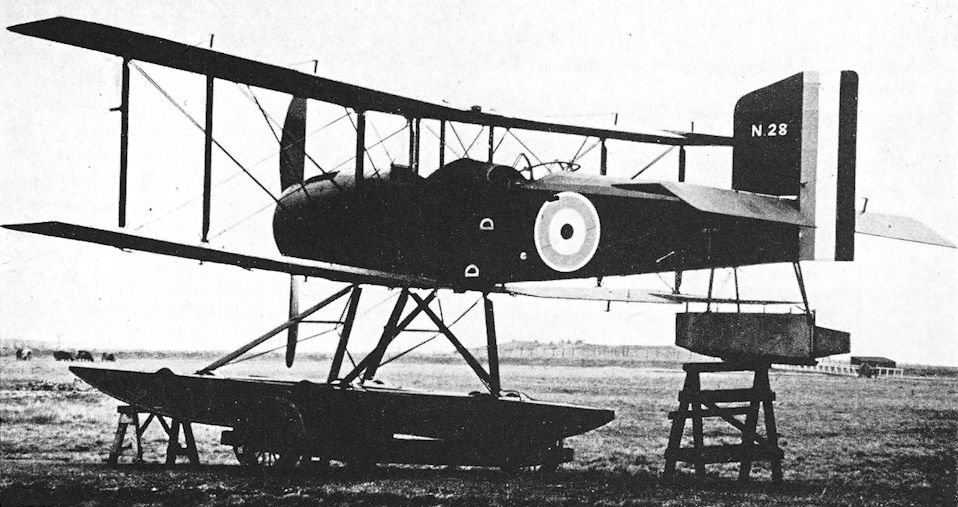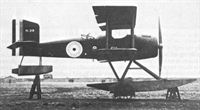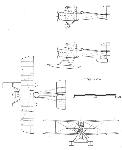C.Barnes Handley Page Aircraft since 1907 (Putnam)
P/320 and R/200 (H.P.13 and 14)
By the end of 1916, the Royal Naval Air Service had accepted the technique of flying-off land aeroplanes from the deck of a seaplane carrier as feasible for active service; single-seat scouts were already replacing float seaplanes for short-range attacks on Zeppelin sheds sufficiently near the coast and the Admiralty invited tenders for larger ship-based bombers, both single- and two-seat, in category N.1a. One such was the Handley Page Type P, designed to carry a crew of two, two machine-guns, four 100 lb bombs, and cameras, but no wireless, with a speed range of 50 mph to 115 mph and climb to 10,000 ft in 20 min. Originally sketched as a biplane for which the intended 200 hp Hispano-Suiza engine was not available, a change was made to the much heavier 320 hp Sunbeam Cossack, which in turn required a large increase in wing area to maintain the same wing loading; since the overall dimensions also had to be kept within close limits, Volkert solved the problem by redesigning this machine, P/320, as a triplane. Two prototypes, N519-N520, were ordered, but cancelled almost at once, after which a fresh start was made with a smaller biplane, Type R/200, when at last a supply of 200 hp Hispano-Suizas had been assured for it.
The R/200 was a small two-seat reconnaissance-fighter intended to operate either as a seaplane or from the decks of HMS Furious and Argus, on which deck landing techniques were being developed during 1917. The specification, in the Admiralty N.2a category, defined dimensional limits to suit the carriers’ hangar space, emphasising interchangeability and ease of maintenance at sea. The engines specified were the Bentley B.R.2 rotary or the 200 hp Hispano-Suiza, which were both in mass production for the Admiralty and War Office. Volkert chose the latter engine and obtained a contract for six prototypes, N27-N32, in the summer of 1917, with a promise of an initial production batch of twenty to follow. Soon afterwards, his involvement with a new heavy bomber project necessitated his delegating the detail design of the R/200 to Leslie Richards, who evolved a neat single-bay biplane of economic construction, with identical upper and lower wings, having 2 degrees dihedral and no stagger; the whole trailing edge aft of the rear spar was taken up by ailerons and camber-changing flaps on both wings. Not only were the ailerons and flaps all of equal span and area, but the port ailerons were interchangeable with the starboard flaps and vice versa. The same principles governed the design of the tail surfaces, where the rudder and each elevator were identical, as were the fin and each half of the tailplane; such comprehensive interchangeability was expected to speed production of components and reduce the variety of spares needed on board ship. The fuselage was a flat-sided wire-braced girder with four spruce longerons and perpendicular struts, stringers being used only to form the curved decking. The pilot occupied the forward cockpit under the centre section and had conventional controls, with the aileron cables arranged to intersect the wing hinge centres so that tension in the circuit was maintained whether the wings were spread or folded. The flaps were pulled down symmetrically, by means of a separate handwheel alongside the pilot, against the tension of rubber cords anchored to the top of the front spar of the upper wing.
The geared 200 hp Hispano-Suiza vee-eight water-cooled engine was neatly installed with a circular front honeycomb radiator and louvred detachable aluminium cowling panels. There were no exhaust manifolds and the petrol in the main fuselage tank between the cockpits was pumped to a small gravity service tank set into the centre-section leading edge. The observer’s cockpit, with its Scarff ring for a Lewis gun, was aft of the centre section and afforded a good all-round view and field of fire for self-defence. The landing gear comprised interchangeable sea and land chassis, the former having twin carvel-built mahogany floats with single steps and shallow V-bottoms, together with a tail float having a strong central skeg and a water-rudder operated directly from the pilot’s rudder bar by separate cables; the main floats were rubber-sprung, but not the tail float. The alternative wheeled chassis had simple V-struts, with a rubber-sprung cross-axle; the tailskid also was rubber-sprung. The third and fourth prototypes were to be delivered with wheels and the other four with floats. Meredith had arranged for most of the work on the production batch to be sub-contracted, with final assembly in requisitioned premises in Cricklewood Lane, as the main factory was fully occupied, and it is believed that serials N6080-N6099 were reserved for production aircraft.
The first two seaplanes, N27 and N28, were tested at the Welsh Harp reservoir at Hendon in December 1917 by Gordon Bell, who ferried them to the RNAS testing station at the Isle of Grain, where the first landplane, N29, also arrived in February 1918; but in view of the overriding priority of O/400 and V/1500 production at Cricklewood the remaining three prototypes and all the production R/200s were cancelled in March 1918. The performance, as tested at Grain, was not outstanding and in general the R/200 was considered inferior to the Parnall Panther, which was faster, lighter and even smaller, with the further advantage that its B.R.2 engine was reliable, whereas the Hispano-Suiza suffered badly from reduction gear and crankshaft failures. Possibly the R/200 could have been refined and improved, but for the more urgent demands of the V/1500.
R/200 (200 hp Hispano-Suiza)
Span 36 ft (10-97 m); length (seaplane) 29 ft 8 in (9-1 m), (landplane) 25 ft 6 in (7-77 m); wing area 390 sq ft (36-2 m2). Empty weight 1,882 lb (853 kg); maximum weight 2,990 lb (1,355 kg). Speed 93 mph (150 km/h); ceiling 12,000 ft (3,710 m). Pilot and observer.
J.Bruce British Aeroplanes 1914-1918 (Putnam)
Handley Page R/200
THE Handley Page R/200 was a two-seat reconnaissance biplane of compact design which was built for the Admiralty in 1917; it was regarded as appropriate to the Admiralty category N.aA. It was. powered by a 200 h.p. Hispano-Suiza engine, and had interchangeable wheel and float undercarriages: it was flown in both forms. The floatplane version was first flown from the Welsh Harp by Gordon Bell,, and both versions were officially tested at the Isle of Grain Test Depot: the landplane R/200 was there in. February, 1918.� The R/200 was a neat and orthodox aeroplane, and was one of the smallest British two-seat Service seaplanes of its day. It contrasted oddly in size with the other Handley Page products of the period. The wings could be folded, and incorporated a form of variable camber gear on their trailing edges. The vertical tail surfaces were of a shape which re-appeared only slightly altered in the much later and larger Handley Page Hyderabad, Hinaidi and Clive.
The main floats of the seaplane version were of the pontoon type with a single step well aft. A two-bladed airscrew was fitted. The undercarriage of the landplane was a simple vee structure, and the engine drove a four-bladed airscrew of smaller diameter.
SPECIFICATION
Manufacturers: Handley Page, Ltd., Cricklewood, London. Power: 200 h.p. Hispano-Suiza.
Dimensions: Span: 36 ft. Length: floatplane 29 ft 8 in., landplane 25 ft 1 in. Height: floatplane 12 ft, landplane 10 ft 9 1/2 in. Chord: 6 ft. Gap: 6 ft. Stagger: nil. Dihedral: 2°. Incidence: 2° 30'. Span of tail: 13 ft 9 1/2 in. Airscrew diameter: 9 ft. Each float: 16 ft 6 1/4 in. X 2 ft 4 1/2 in. Distance between float centre-lines: 9 ft. Wheel track: 6 ft. Tyres: 750 X 125 mm.
Areas: Wings: 390 sq ft.
Weights (lb) and Performance:
Version Floatplane Landplane
Date of Trial Report - March nth, 1918
Type of airscrew used on trial - A.B.7282
Weight empty 1,712 1,882
Military load - 302
Crew - 360
Fuel and oil 0 446
Weight loaded 2,834 2,990
Maximum speed (m.p.h.) at
sea level 93 -
6,500 ft - 95
10,000 ft - 89
m. s. m. s.
Climb to
6,500 ft - - 15 20
10,000 ft - - 29 30
Service ceiling (feet) - 12,000
Armament: One Lewis machine-gun on Scarff ring-mounting on rear cockpit.
Serial Numbers: N.27-N.32.
H.King Armament of British Aircraft (Putnam)
R/200. Reconnaissance was the mission of this compact single-engined biplane, built for the RNAS in 1917. A Lewis gun on a dorsal Scarff ring-mounting apparently comprised the sole armament.






